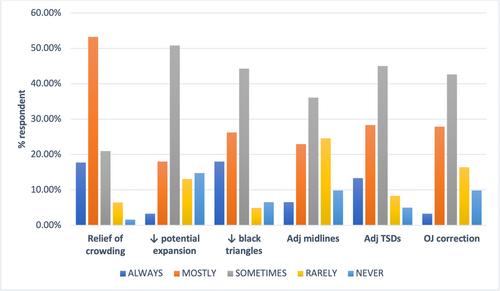A Cross-Sectional Survey of the Use of Clear Aligners by General Dentists in Australia
Abstract
Objectives
The primary aim of the investigation was to survey clear aligner therapy (CAT) use among general dentists in Australia. A secondary aim was to evaluate the factors that influenced general dentists in Australia not to provide CAT.
Material and Methods
General dentists registered with the Australian Health Practitioner Regulation Agency were invited to participate in a structured cross-sectional electronic survey. The survey covered demographics, preferred CAT systems and practices, relevant treatment planning and retention protocols, patient-reported CAT issues, pertinent respondent opinions, and reasons for not providing CAT. Descriptive statistics were computed via GraphPad Prism v10 (GraphPad Software Inc., La Jolla, CA, USA).
Results
Most of the 264 (n = 172; 65.2%) respondents indicated that they provided CAT. The majority (n = 82; 58.6%) reported that they treated between 1 and 20 patients with CAT annually. Invisalign was the most used system (n = 83; 61.2%), with 55 (41.7%), indicating that they used more than one system. Most (n = 124; 98.4%) were comfortable using CAT for mild crowding, whereas 73.4% (n = 94) were not comfortable in treating severe crowding with CAT. The median (IQR) number of patients per respondent treated with extraction of a permanent incisor or premolar was 0 (0). Issues regarding tooth positions were reportedly always or mostly in need of change in the initial treatment plan by 68.7%. Problems regarding patient compliance with CAT wear protocols (n = 67; 45.6%) and the predictability of treatment outcomes (n = 31; 21.1%) were the most identified themes of the free-text comments. Over 80% of those who did not provide CAT indicated that they preferred to refer to an orthodontist for management.
Conclusion
Almost two-thirds of the respondents provided CAT. Invisalign was the most used system. The majority use CAT combined with nonextraction treatment. Most of those who did not provide CAT preferred to refer to an orthodontist for patient management.


 求助内容:
求助内容: 应助结果提醒方式:
应助结果提醒方式:


